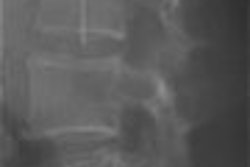Good colonic insufflation is key for successful virtual colonoscopy, but patient comfort is also critical if the procedure is to become a popular method of screening for colorectal cancer. Are the two goals compatible?
In a new multicenter study, researchers from University of Wisconsin Medical School in Madison; Ministry-Health-St. Mary's Hospital in Rhinelander, WI; and the Uniformed Services University of the Health Sciences in Bethesda, MD, compared patient-controlled room-air insufflation to automated CO2 insufflation to determine if one offered better distension and/or less discomfort than the other.
While both methods yielded similar overall results, CO2 distension was slightly better in supine positioning.
"Collapsed or poorly distended segments lower the sensitivity for polyp or mass detection," wrote Dr. Theodore Shinners, Dr. Perry Pickhardt, Dr. Andrew Taylor, Dr. Debra Jones, and Cara Olsen. "These inadequately distended segments may also lead to an increased false-positive rate because they can mimic carcinoma. Given that CTC (CT colonography or virtual colonoscopy) is performed without sedation, this distension must be achieved with an acceptable level of patient discomfort if it is to be widely embraced" (American Journal of Roentgenology, June 2006, Vol. 186:6 pp. 1491-1496).
The researchers, considering patient-controlled room-air insufflation and automated CO2 delivery to be the best currently available preimaging insufflation methods, sought to prospectively compare the two with regard to both distension and patient comfort at screening VC.
Manual room-air insufflation has been compared to the automated CO2 method in previous studies, with CO2 generally performing equal to or better than room air. However, comparison of the present methods has not been performed to the authors' knowledge.
Patient-controlled room air is generally better tolerated and provides better distension than staff-controlled room-air insufflation, although both techniques are safe, according to the researchers. "Rare perforations in symptomatic patients have occurred, however, when the patient did not control the insufflation," they wrote.
The 208 patients who completed the study were randomized to either patient-controlled room air (n = 104; 55 women and 49 men, mean age ± SD = 56.6 ± 9.2 years) or automated CO2 insufflation (n = 104; 55 women and 49 men, mean age ± SD = 57.1 ± 7.8 years).
After cathartic bowel cleansing and before CT imaging, colonic distension was performed with a small flexible rectal catheter using either a standard handheld air bulb insufflator for room air, or an automated CO2 delivery system (ProtoCO2l, E-Z-EM, Lake Success, NY). For the latter, manufacturer's default setting of 25 mm Hg equilibrium pressure was used, with the relief valve set at 50 mm Hg, according to the authors.
Colonic distension was subjectively assessed segment by segment on a four-point scale, with 1 signifying optimal distension and 4 meaning collapsed in any part of the segment. The adequacy of combined prone/supine segmental evaluation was also assessed. In addition, patients rated discomfort on a scale of 0-10, with 7-10 being significant.
"No significant differences in segmental distension were seen in the prone position between the two techniques," (p = 0.078 and p = 0.898, respectively) the group reported.
In the supine position, the CO2 method yielded significantly greater distension in the sigmoid, descending, and transverse segments (p < 0.01), including overall improved distension with CO2 compared with patient-controlled room air. However, a significant overall distension advantage was not seen with either method (p = 0.4).
The colon was divided into six segments for evaluation. "On individual segmental evaluation, 171 (6.9%) of 2,496 total segments were judged to be distended inadequately (score of 3 or 4)," the authors reported." No significant difference in the number of inadequately distended segments was found comparing (room air) and CO2, with 84 (6.7%) of 1,248 and 87 (7.0%) of 1,248 segments, respectively."
Discomfort levels were a mixed bag, with CO2 levels higher during insufflation, then quickly dropping below room-air discomfort levels for the rest of the procedure.
"Mean discomfort scores for (room air) and CO2 were 3.97 and 5.08 during the examination (p < 0.01); 0.91 and 0.42 immediately after (p < 0.01); 0.51 and 0.25 15 minutes later (p < 0.05); and 0.15 and 0.04 two hours later (p < 0.01 respectively," they reported. "During active distension, 19 (18.3%) and 33 (31.7% patients reported significant transient discomfort with (room air) and CO2, respectively (p < 0.05). Beyond 15 minutes, only two (1.9%) patients with (room air) and no patients with CO2 had a discomfort level higher than 3."
Room air's lower discomfort levels during insufflation "may be due in part to the patient's ability to control the rate of distension with (self-controlled room air) perhaps avoiding rectal spasm," the authors wrote.
In addition, CO2 discomfort levels may be reduced by adjusting the insufflator settings. "Lowering the targeted equilibrium pressure may in fact decrease the number of patients experiencing significant discomfort during active distension with CO2," they stated.
Since the study ended, the group has lowered its equilibrium pressure setting for automated CO2 from 25 mm Hg down to 20 mm Hg, "which appears to result in decreased patient discomfort during active distension," according to the authors.
As for the comparatively lower levels of patient discomfort after distension with CO2 compared to room air, the observation may be related to the more rapid resorption of CO2," Shinners and colleagues wrote.
"Most patients had negligible discomfort and were able to resume normal activities shortly after examination completion," the team wrote. "This differs from conventional colonoscopy, which requires longer recovery secondary to conscious sedation."
Limitations included the exclusion of 14 patients with baseline discomfort scores greater than 1 who were dropped due to the potential difficulty of separating baseline from overall discomfort. Also, assessment of colonic distension was subjective, as was self-assessment of discomfort by patients, "which can be highly subjective," the researchers wrote, adding that differences in discomfort scores between insufflation methods are more meaningful than absolute scores.
"Given the small but definite improvement in colonic distension, the improved patient comfort postprocedure, and the better overall acceptance by CT technologists, we have switched over to automated CO2 insufflation as the frontline distension technique for our (VC) screening program," they wrote. "Patient-controlled (room-air) insufflation, however, remains a viable alternative and serves as a trusted backup."
Although both methods produced negligible discomfort and reliable distension, "CO2 was better for both categories," the group concluded. "The decision of which technique to use should be individualized to best suit a given (VC) program."
By Eric Barnes
AuntMinnie.com staff writer
June 2, 2006
Related Reading
Automated CO2 insufflation maintains lead, December 30, 2005
Automated CO2 insufflation improves VC, December 1, 2004
Electronic CO2 insufflation beats air in virtual colonoscopy, March 12, 2003
Copyright © 2006 AuntMinnie.com



















